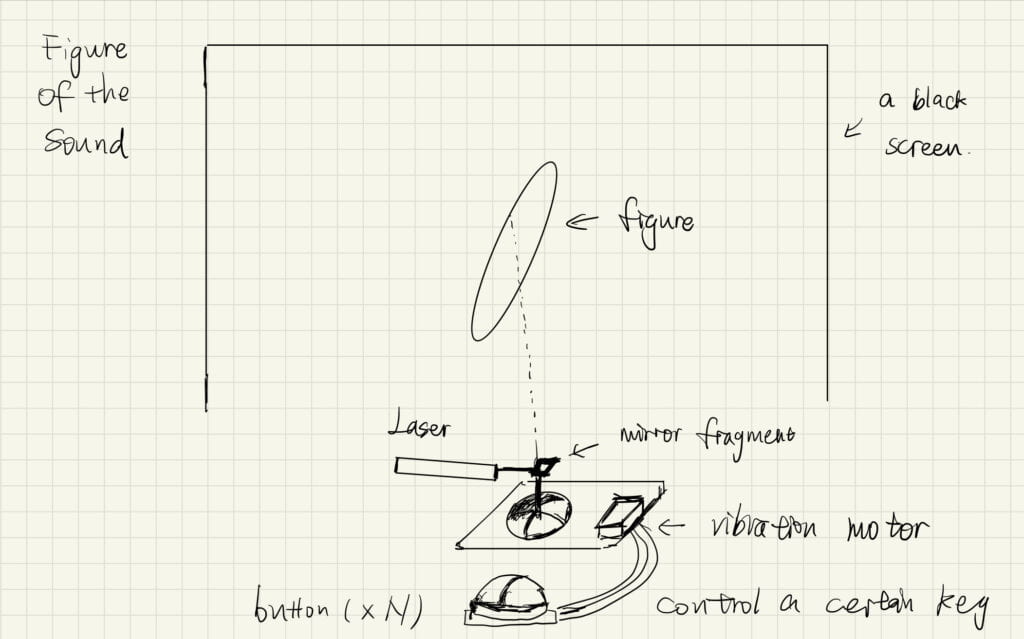Three Project Proposals
Freddie
1. The figure of the sounds
I researched the project called Laser + mirror + sound carried out by a YouTube blogger called Steve Mould, here is the video:
The project used sound vibration to record different frequencies of the sound, used a little mirror to expand the effects of the vibration and used laser to reflect the vibration to a screen and showed the graph of the vibration. The most exciting things about this project is that when different vibration of sounds are added together, the graph will show different but complex types of animations. The more sounds are added, the more complex it becomes. I’ve beee thinking of working on sound visualization for quite a long time. This project gives me some insights that broaden my imagination on how the visualization can be like instead of using only NeoPixels or screen effects that change according to the music.
I’m currently thinking of using PressButtons, vibration motor in Arduino, a laser launcher and a small fragment of mirror to create sound visualization. The vibration motor will also be connect to a Processing String that shows how the vibration look like using the sound sensor to sense the loudness and converted into vibrating graph in Processing. I’ll build buttons for different keys of sound in a certain instrument or effect. The buttons can be pressed at the same time so that it gives the animation more complexity, as well as the vibrating string. The buttons allow users to create music and different appearance of animations. They can play in either single key or chords which gives the project more possibilities. The project tells people how the sounds “look like” in a relatively vivid way and in the meantime allow the audience to enjoy creating different animating shapes while playing simple music.



2. The Bouncing Ball
I got this idea from the Recitation 8: Serial Communication. From task 2, a bouncing ball that moves in horizontal direction is “bounced back” by two hands on both sides of the screen using two Arduino Servos. But the servos are not actually interacting with the bouncing ball, they are programed to do so. Thus, I’ve come up with more interactive way to do so. I’ll create two different values in processing using the slide potentiometer. The ups and downs of the side potentiometer serves as an obstacle that moves up and down on the screen in a Processing sketch. The audience will be two players on two sides and they try to avoid the bouncing ball from getting into the goal area behind each obstacle. Each ball in the goal area is worth one point and who gets to three point first will win the game. The player will try their best the reacts to high-speed moving bouncing ball and keep them off from their goal areas. To avoid the game from taking too much time, the linear obstacle will reduce every five seconds and the game becomes harder since then.

3. Pairing
This is an interactive game that stemmed from an old and simple video game that players unfold different patterns and try to find the same pairs and eliminate them. I would like to use an NeoPixel 8*8 Flexible and 16 weight sensors in Arduino and serial.Record and serial.Send in Processing to set the lights in different colors and the rules and mechanism of the game. The weight sensor will be set under every four NeoPixels and a certain kind of pattern made by paper will be sticked on top of all the NeoPixel, the audience can press on those NeoPixels to trigger the weight sensor and the light will be on an shows a certain color according to the Processing settings. If a player clicked on the different colors, they will both disappear then, if same, they will remain, and after all the NeoPixels are paired, the NeoPixel will show short light shows based on how fast the player has completed the game to indicate a small reward.
The project reminds me of the simple but interesting games I’ve played in my childhood but in a novel way. In this case, the lights are adding instead of disappearing so when it is completed it gives you more direct and physical feed back which is a light show. It also contains a loop of pairing, disappearing, pairing, staying, pairing…… That gives it more interaction between user and the artifact.

